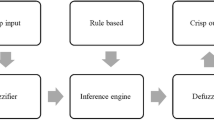Abstract
In this paper, we propose an artificial neural network (ANN) model for prediction of color properties, including color yield (in terms of K/S value) and CIE L, a and b values of 1005 cotton knitted fabrics under the effect of laser engraving process with different process parameters. Fabric factors to be examined in the ANN model included fiber composition, fabric density, mass of fabric, fabric thickness, linear density of yarn, yarn twist, direction of yarn twist and crimp. After obtaining the ANN model, its performance was compared with linear regression model. It is noted that the ANN model produced superior results in prediction of color properties of laser engraved 100 % cotton knitted fabrics. The relative importance of the examined factors influencing color properties was also investigated.





Similar content being viewed by others
References
Dascalu T, Acosta-Ortiz SE, Ortiz-Morates M, Compean I (2000) Removal of the indigo colour by laser-beam-denim interaction. Opt Lasers Eng 34:179–189
Ortiz-Morales M, Poterasu M, Acosta-Ortiz SE, Compean I, Hernandez-Alvarado MR (2003) A comparison between characteristics of various laser-based denim fading processes. Opt Lasers Eng 39:15–34
Ondogan Z (2005) A laser surface design machine to improve the productivity of textile manufacture. Lasers Eng 15:375–385
Gao Z, Zhang L, Zhao J (2006) Application of laser technology in textile industry. J Text Res 27(8):117–120
Ondogan Z, Pamuk O, Ondogan EN, Ozguney A (2005) Improving the appearance of all textile products from clothing to home textile using laser technology. Opt Laser Technol 37:631–637
Hung ON, Song LJ, Chan CK, Kan CW, Yuen CWM, Zhang YH (2011) Prediction of laser-treated knitted fabric colour properties based on a new elman neural network. In: Proceedings of 2011 international conference on future computer sciences and applications, 182–186
Hung ON, Song LJ, Chan CK, Kan CW, Yuen CWM (2011) Using artificial neural network to predict colour properties of laser-treated 100 % cotton fabric. Fibers Polym 12(8):1069–1076
Hung ON, Song LJ, Chan CK, Kan CW, Yuen CWM (2012) Predicting the laser-engraved colour properties on cotton-spandex fabric by artificial neural network. AATCC Rev 12(3):57–63
Hung ON, Chan CK, Kan CW, Yuen CWM, Song LJ (2014) Artificial neural network approach for predicting colour properties of laser-treated denim fabrics. Fibers Polym 15(6):1330–1336
Kan CW, Yuen CWM, Cheng CW (2010) A technical study of the effect of CO\(_{2}\) laser surface engraving on some colour properties of denim fabric. Color Technol 126:365–371
Kan CW (2014) CO\(_{2}\) laser treatment as a clean process for treating denim fabric. J Clean Prod 66:624–631
Kerh T, Chan Y, Gunaratnam D (2009) Treatment and assessment of nonlinear seismic data by a genetic algorithm based neural network model. Int J Nonlinear Sci Numer Simul 10:45–56
Chang LC, Chang FJ, Hsu HC (2010) Real-time reservoir operation for flood control using artificial intelligent techniques. Int J Nonlinear Sci Numer Simul 11:887–902
Murrells CM, Tao XM, Xu BG, Cheng KPS (2009) An artificial neural network model for the prediction of spirality of fully relaxed single jersey. Text Res J 79:227–234
Pynckels F, Kiekens P, Sette S, Van-Langenhove L, Impe K (1995) Use of neural nets for determination the spinnability of fibres. J Text Inst 86:425–437
Fan F, Hunter L (1998) A worsted fabric expert system part II: an artificial neural network model for predicting the properties of worsted fabrics. Text Res J 68:763–771
Majumdar PK, Majumdar A (2004) Predicting the breaking elongation of ring spun cotton yarns using mathematical, statistical and artificial neural network models. Text Res J 74:652–655
Beltran R, Wang L, Wang X (2006) Measuring the influence of fiber-to-fiber properties on the pilling of wool fabrics. J Text Inst 97:197–204
Hornik K, Stinchombe M (1992) Artificial neural networks: approximation and learning theory. Blackwell press, Oxford
Cybenko G (1989) Approximation by superpositions of a sigmoid function. Math Control Signals Syst 2:303–314
Hetcht-Nielsen R (1989) Theory of the backpropagation neural networks. In: Proceedings of international joint conference on neural networks, 1:593–611
Huang SC, Huang YF (1991) Bounds on number of hidden neurons in multiplayer perceptions. IEEE Trans Neural Netw 2:47–55
Sartori MA, Antsaklis PJ (1991) A simple method to drive bounds on the size and to train multilayer neural networks. IEEE Trans Neural Netw 2:467–471
Acknowledgments
Authors would like to thank the financial support from The Hong Kong Polytechnic University for this work.
Author information
Authors and Affiliations
Corresponding author
Rights and permissions
About this article
Cite this article
Kan, C.W., Song, L.J. An Artificial Neural Network Model for Prediction of Colour Properties of Knitted Fabrics Induced by Laser Engraving. Neural Process Lett 44, 639–650 (2016). https://doi.org/10.1007/s11063-015-9485-7
Published:
Issue Date:
DOI: https://doi.org/10.1007/s11063-015-9485-7




